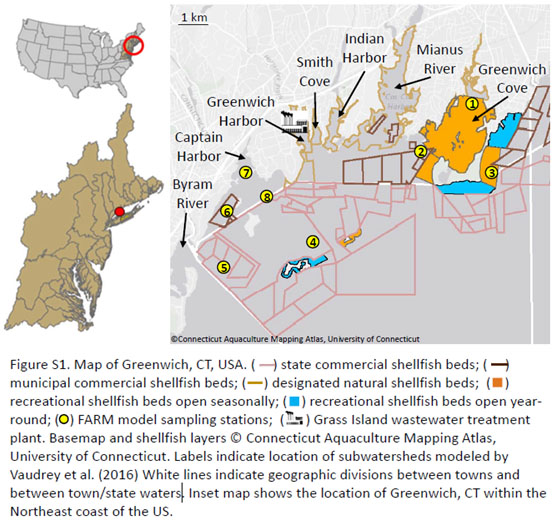Eutrophication, the over-enrichment of the aquatic environment with nutrients, can result in excessive plant growth and loss of oxygen from the water. Shellfish aquaculture eases eutrophication by removing nitrogen through filter feeding. We are working to quantify the value of this ecosystem service at the local level, where shellfish are likely to have the biggest positive effect.
Why We Care
Eutrophication is a global environmental challenge, and diverse watershed nitrogen sources require multifaceted management approaches. Removal of nutrients directly from the water by cultivation of bivalve shellfish has been shown to remove nitrogen. Bivalves filter water as they feed and remove nitrogen contained in plankton and detritus, transferring nitrogen from the water column to the sediments as feces or pseudofeces, sequestering some nitrogen in tissue and shell, and excreting the balance as ammonia. Bivalve feeding activities effectively short-circuit accumulation in the environment, but the extent and value of this ecosystem service has not been well-characterized at the local scale. It is important to note that appropriate siting and farm management are needed to maximize environmental benefits and avoid any potential negative environmental effects associated with bivalve aquaculture. Over-enrichment of sediments underlying aquaculture operations can occur in locations with small or no tidal currents, or excessively high densities of shellfish in a farm area.
 What We Did
What We Did
The focus of this study was the quantification and valuation of the ecosystem service of nitrogen removal provided by cultivated Eastern oysters (Crassostrea virginica) and hard clam (Mercenaria mercenaria). We developed a novel approach to estimate the value of oyster and clam aquaculture to nitrogen reduction in a coastal community in Greenwich, Connecticut. We used two methods to estimate nitrogen removal by shellfish aquaculture. One method used nitrogen removal from annual harvest for a well-established shellfish aquaculture industry. The other allowed ecosystem managers to project potential nitrogen removal of a new or growing industry using a modeling approach. We assigned a value to the removed nitrogen based on the alternative nutrient management strategy that would be required (e.g., septic upgrades, centralized sewage treatment). This novel application of the replacement cost approach quantified and valued nitrogen reduction services provided by hard clam and eastern oyster aquaculture industries to a municipality.
What We Found
Using the preferred analysis of allocating replacement costs by nitrogen source, aquaculture-based removal of 14,006 kg nitrogen was valued at $2.3−5.8 (2.3−6.4€) million per year. This nitrogen removal represents 9 percent of the total annual Greenwich-specific nitrogen load, 16 percent of the combined nonpoint sources, 38 percent of the fertilizer sources, 51 percent of the septic sources, 98 percent of the atmospheric deposition to the watershed, or 184 percent of the atmospheric deposition to the embayments that discharge to Greenwich Bay.
Benefits of Our Work
Our approach is transferable to other coastal watersheds pursuing nitrogen reduction goals, both with and without established shellfish aquaculture. It provides context for decisions related to watershed nitrogen management expenditures and suggests a strategy to comprehensively evaluate mechanisms to achieve nitrogen reduction targets.
